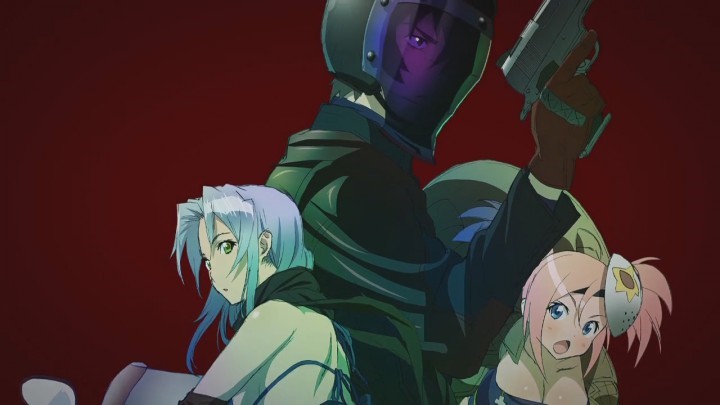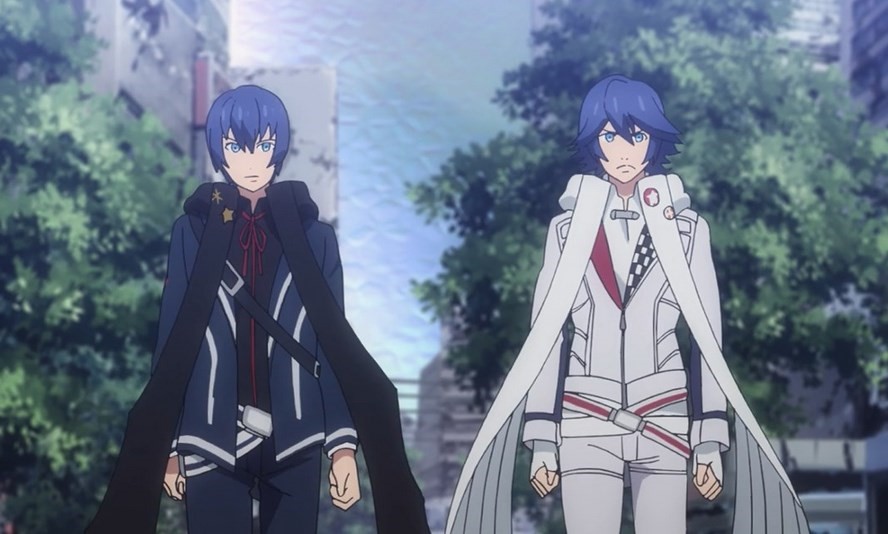March 13th, 2016 in Anime, General Reviews, My Teen Romantic Comedy SNAFU by The Droid

I never felt there was a need to have a second season, but I have to assume that it scored so well with others that we had to cash in on the popularity. So, here we are with “My Teen Romantic Comedy SNAFU, Too” (”Yahari Ore no Seishun Rabu Kome wa Machigatteir”), subtitled “My Youth Romantic Comedy Is Wrong as Expected” and abbreviated as “Hamachi’ and “OreGairu”. Now, I always have the suspicion if you can’t agree on a title, there are bigger problems afoot. But this show has always been kind of like that.
The show starts off in all-too-familiar territory, as Hachiman Hikigaya is still a Class-A grumpy slacker (in the middle, the Class-A grumpy slacker), but we see a kind of evolution as chinks appear in his armor, so the truth comes out. He seems to be getting pushed around by the other members of the Service Club, Yukino Yukinoshita (left) and Yui Yuigahama (right). It starts out with basic help for people with basic problems, but it is done is a rather ‘let’s get it done’ manner, just to get it done and not to resolve things properly.
The big drag is that it takes about six episodes for a real plot to finally show up and it is at that point the show not only gets interesting, but starts to pick up, both in vitality and intensity. Until then, it is merely going through the motions, unless that is the intent of things. We also start to see that Hachiman is really to blame for how he feels, as he doesn’t really know how to express himself to others and himself, but lashes out at others for these failures and he makes some doozy failures (the love confession episode). (more…)
Tags: Comedy, Romance, School
February 25th, 2016 in Anime, General Reviews, Triage X by The Droid

There is something about vigilante shows that satisfy a primal need for justice to be dished out. Too bad “Triage X” does it wrong. Or at least a wrong presentation of things.
The story starts out simple enough: Arashi Mikami (that helmeted dude) works for Mochizuki General Hospital. However, underneath that gleaming exterior of helping people to heal resides the vigilante organization known as “Black Label.” The team, made up of select hospital staffers and local teenagers from nearby Mochizuki High School, task themselves with killing undesirable people, dubbed “cancers” of society, and to stop their spread of infection into the ‘body’ of the populace.
Now, these criminals are, hands down, guilty, guilty, guilty. They cannot be brought to justice through normal channels, as they will use their money and influence to prevent that from happening. Mikami and his support team are tasked with taking care of business. The problem is the support (or lack thereof). (more…)
Tags: Action, Adventure, Ecchi, Shounen
February 21st, 2016 in Anime, General Reviews, Yamada-kun and the Seven Witches by The Droid

You knew this kind of series was coming: it’s a magical girl show, set in a school, with guys trying to figure it all out and witches who seem to have an upper hand in things. CUTE witches (none of that old crone with a warty nose junk). But “Yamada-kun and the Seven Witches” (“Yamada-kun to 7-nin no Majo”) at least tries to put a new spin on old things.
Ryu Yamada (Mr. Shrieky in the upper left) is known as a delinquent in his high school; he has become bored of classes after one year of attending school. Wow, life can’t all be “Die Hard” or “The Expendables”, right? One day, he accidentally falls from a flight of stairs onto Urara Shiraishi (blondie in front) the ace student of the school. Yamada wakes up to find that he has swapped bodies with her. The two try to reverse the change and discover that kissing triggers the body swap.
On the suggestion of student council vice-president Toranosuke Miyamura, they revive the Supernatural Studies Club. The supernatural phenomenon-obsessed Miyabi Itō soon joins the club. The club encounters other “witches” with different powers that are activated with a kiss. A transfer student, Kentarō Tsubaki, becomes a part of the club after nearly causing a fire to the old schoolhouse. The show is an attempt to understand the seven witches that populate it, what their powers are and what their actual purpose is. (more…)
Tags: Comedy, Harem, Mystery, Romance, School, Shounen, Supernatural
February 18th, 2016 in Anime, General Reviews, Nisekoi by The Droid

As always, with the conclusion of the first season of “Nisekoi” (“False Love”), none of the original questions were answered, new characters entered and the plot was complicated by Ichiro’s faulty memory, so the real question was how long we would have to wait for the second season. With a couple of bridge OVAs to keep us interested and fill in some gaps, we now have our second season, but it is more of a conduit, as we further complicate matters with, uh, further complications.
We had best run down the now capacious cast.
Upper left photo (left to right): Chitoge Kirisaki and Marika Tachibana
Upper right: Fuu, Seishiro Tsugumi and Paula McCoy
Lower right: Haru Onodera (sister to Kosaki) and Raku Ichijo
Lower left: Ruri Miyamoto, Kosaki Onodera and Shu Maiko (more…)
Tags: Comedy, Harem, Romance, School, Shounen
February 14th, 2016 in Anime, General Reviews, Gunslinger Stratos: The Animation by The Droid

This is a show with an interesting concept: what if you had to do battle with an opposing force, bent on destroying your world? What if your opponent was an evil version of yourself? What if you were deemed the evil version and not the other one? That is the initial concept with “Gunslinger Stratos: The Animation” (“Gansuringā sutoratosu Animēshon”). Now, this started out life as a third-person shooter (easily seen amid all the fighting sequences), but morphed into this series.
In the year 2115, the country known formerly as Japan has been split into two parallel worlds: the Frontier S (Stratos) and the 17th Far East Imperial City Management District. Frontier S is an outlaw universe in which freedom runs rampant (damn those freedom seeking radicals!), while the 17th Far East Imperial City Management District is a totalitarian universe, completely bereft of freedom and is under constant surveillance.
While the two universes are just starting to fuse into one, the governments of each world initiates Operation Stratos, a world-scale protocol wherein a handpicked group of gunslingers, mercenaries, street punks and special individuals, each from the two universes, will be sent in the year 2015, to alter the past by eliminating the other side until only one group survives, erasing a parallel universe in the process. No pressure, right? (more…)
Tags: Action, Sci-Fi
February 11th, 2016 in Anime, General Reviews, Hibike! Euphonium by The Droid

After the success that I had with “Your Lie in April”, I decided to tackle “Hibike! Euphonium”, another music-based anime. Well, the full title is (take in a huge gulp of air) “Hibike! Yūfoniamu Kitauji Kōkō Suisōgaku-bu e Yōkoso” or “Resonate! Euphonium. Welcome to Kitauji High School’s Wind Ensemble Club”. And if you can say that on one breath, perhaps you should consider playing the euphonium. For those who are not fully certain, a euphonium can be thought of as a smaller tuba, a bit easier to transport and with a better tone, much like its brother, a baritone horn.
Anyway, to the plot. The Kitauji high school concert band club had at one time participated in national tournaments and was a champion school, but after the club’s adviser changed, they have not been able to even participate in the qualifying tournament. At this point, we are talking perhaps at least five years, and possible closer to ten. However, thanks to the newly appointed adviser’s strict instruction, the students are steadily improving and build up their strength.
Our lead is Kumiko Oumae, who has been playing the ‘euph’ since she was a little child. She decides to join the band when her friends also wish to, and she discovers she would not be the only euph player on the band. Sapphire Kawashima is a deadlock for the band, as she is the only contrabass player. Unless you have zero ability, you are guaranteed a spot on the band with a rare instrument in a high school band. Hazuki Katou was a trumpet player, but they needed someone on tuba and she ‘won’, as they had a surplus of trumpets, led by Reina Kousaka. Now she is REALLY good, but has personality problems. (more…)
Tags: Drama, Music, School
February 7th, 2016 in Ane-log, Anime, General Reviews by The Droid

This particular comedy “Ane-log” (“Sister Log”, or the complete title of “Ane-log: Moyako Nee-san no Tomaranai Monologue” which is “Moyako’s Never-Ending Monologue”) is strange in that it has a fundamental flaw, but that doesn’t prevent us from having a lot of fun with it.
Many, many years ago, let’s say 10 years earlier or so, Akira told his slightly older sister Konoe that he wanted to marry her. Now, at this very point in their lives, Moyako is wholly, solely convinced that Akira is a grand pervert who wants nothing more than to physically and emotionally subjugate her into being a sex slave. Nothing could be farther from the truth, but Moyako’s overheated imagination runs rampant and even the slightest gesture or comment sends her reeling. SHE is the big pervert and nothing can rein in her unbridled thoughts.
The above scene comes from when Akira spilled coffee on himself and Moyako thinks he is going to use this as an excuse to strip down and flaunt his goodies before her. So what’s the flaw? Why is it now? Why is all of this coming to fruition at this juncture in time? (more…)
Tags: Comedy, Ecchi, School, Shounen
February 4th, 2016 in Anime, General Reviews, I Can’t Understand What My Husband is Saying by The Droid

“I Can’t Understand What My Husband is Saying” (“Danna ga Nani o Itteiru ka Wakaranai Ken”) is a brief (about four minutes), episodic show about the married life between Hajimi, a 23-year old otaku who scrapes by living as a blogger and Kaoru, a 25-year old office lady who is adjusting to married life with an otaku husband.
The show starts off a few weeks after they have been married, so we are still in a period of adjustment for them. You get the feeling that they just don’t know all that much about one another and she got married because she was afraid that she would never be married. Aside from having with their interpersonal issues, there are their friends to deal with, and a larger assortment of loonies you have never met or seen.
This show really works well with binge watching. I mean, they are only four minutes a pop, so you can clobber the first season in about an hour. There is a second season out as well, but you get the feeling that the shows are ‘mixed up’. The order they are presented is not the order they should be in, so it flows better, but perhaps that is the comment they are making, that life is rather episodic and that compatibility is difficult, especially when you are just starting out. (more…)
Tags: Comedy, Seinen, Slice of Life
January 31st, 2016 in Anime, General Reviews, Punch Line by The Droid

This is one of the more complicated, convoluted shows I have seen, up there with “Mekakucity Actors”, “Steins;Gate” and “Chaos;Head” in that you are not really certain what is going on. The fact and/or problem that it also has to deal with the concepts of time travel, physical possession and grand conspiracies make “Punch Line” (“Panchi Rain”) a rather hard show to follow.
Yūta Iridatsu (the only boy up there) lives at the Korai House apartment complex with four girls (left to right): Rabura Chichibu, Meika Daihatsu, Ito Hikiotani, and Mikatan Narugino. One day, following a bus-jacking incident, Yūta finds himself ejected from his own body and becoming a ghost of some sort. Guided by the cat spirit Chiranosuke, Yūta must learn to master his spirit powers in order to protect his housemates from the various circumstances they find themselves in. However, if Yūta sees a girl’s panties twice in a row, the Earth will be destroyed by a meteor. OK, that sounds simple, but the execution is lumpy. It doesn’t help that we are seemingly trapped within the same time frame (December 21 to 31) and unable to correct or change the circumstances.
Also, with Yuta a ghost for the first half of the show and Chiranosuke really a huge caliber of tyrant, this makes for a confusing situation. We slowly learn the rules and logic of this realm he is in, but also the limitations that he has. (more…)
Tags: Comedy, Ecchi, Sci-Fi, Super Power, Supernatural
January 28th, 2016 in Anime, General Reviews, Plastic Memories by The Droid

It took me a little while to tumble to “Plastic Memories” (“Purasutikku Memorīzu”), but I realized that it was a take on the “Mahoromatic” theme of limited time and why must this have to be this way? (Disclosure time: “Mahoromatic” is my personal best anime series, as I have all the DVDs plus I have done about 100 fanfics for it).
We are in the future and the future has androids. SAI Corporation, the leading android production company, has introduced the Giftia, a new android model with the most human-like qualities of any model. The lifespan of a Giftia is 81,920 hours (roughly nine years and four months), but if they pass their expiration date, it causes personality disintegration, memory loss and outbreaks of violence. Kind of like a football fan in the off-season.
As a result, the employees of the Terminal Service (responsible for retrieving androids which are close to reaching the end of their service lives and erasing the androids’ memories) must go to the owner of the Giftia and retrieve it. Those assigned to the Terminal Service work in teams consisting of a human (called a “Spotter”) and a Giftia (called a “Marksman”). The story follows protagonist Tsukasa Mizugaki (far right) and a Giftia named Isla (next to him), both of whom work in SAI Corp’s Terminal Service No. 1 office. (more…)
Tags: Drama, Romance, Sci-Fi









